13 April
Even though sugar making finished in our bush two weeks ago, the maples were spilling sap on the ground today when I drove my little tractor into the wood-lot.
11 April
Yard work has been limited because of cold temperatures, but yesterday I pruned trees around the orchard and lawn. Maples which I trimmed were still running, though apple and walnut trees showed no sap.
7 April
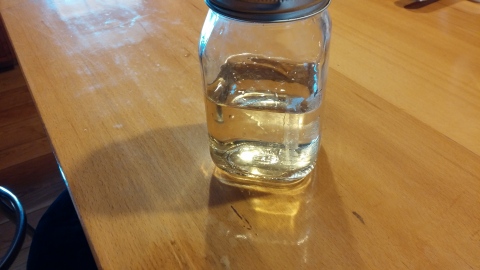
This was all of the walnut sap I harvested this year. Filtering removed the greenish tinge. The remaining sap had a pleasant, innocuous taste and a 5% sugar content. When reduced to where it took on some colour, the sap had a “pleasant and distinctive flavour,” definitely worth further experimentation next year.
5 April
It’s been too cold for any sap to run. April’s a cruel month, eh? And a snowstorm’s due at 7:00 a.m. tomorrow.
2 April
7:15 a.m.
Very cold outside. On impulse I tapped a pair of black walnut trees. They’ll likely run, as the freeze-thaw cycle clearly isn’t finished for the year. More to the point, hard maples were running about 4% sugar over the last few days of the season. It’s the perfect time to test walnut sap for sugar content and flavour.
First impression: a very limited amount of sap showed a faint emerald hue, wasn’t sweet, and had a surprising flavour I can’t liken to anything I have tasted before. After the initial shock passed, it wasn’t bad. The closest I could come would be “nutty.” But the two samples from different trees were markedly different within the range — rather like the range of flavour of black walnuts themselves. It often seems to me that no two nuts taste alike. Anyway, forget the easy accessibility of maple sap and maple syrup. This is a whole new flavour range. In retrospect, I believe the various flavours were from the bark of the tree carried by the sap from each new hole.
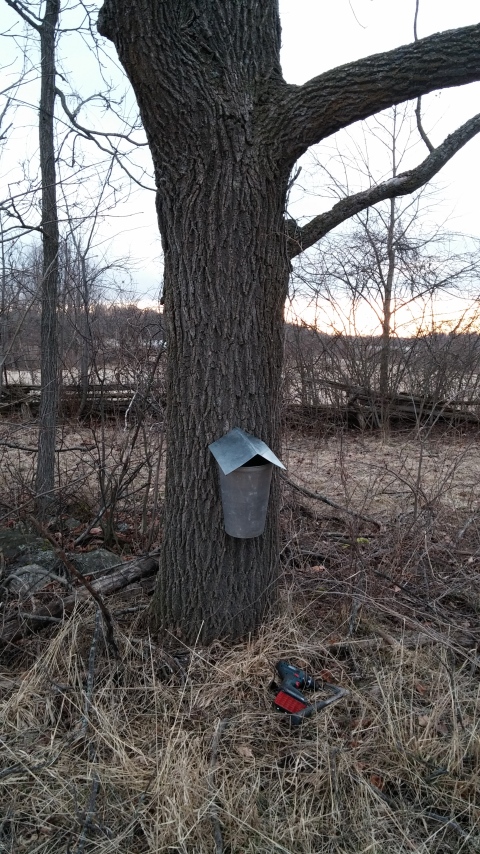
The Croskery woodlot has several dozen mature walnut trees which will never make veneer logs, so they would be candidates for an exotic sugar harvest if the sap is sweet. I fear it will test out at 1%, like that of soft maples, but the time to try it is when the window presents itself.
1 April
Cleanup day. I pulled the buckets and carried them out to the Ranger parked in the adjoining field to avoid rutting the woodlot trails. Very muddy conditions at the moment.
With an outside garden hose finally attached, abundant hot water was available in the pan for cleanup, though I had to drain all lines again because of another overnight freeze.
We’ve had a good run. Thanks to all who contributed.
31 March
Pouring rain, but a good day to boil off remaining sap. This turned into a day-long gabfest around the fire in the shack where returning Snowbird Les Parrott gained instruction in the ways and mores of the Forfar Sugar Syndicate.
30 March
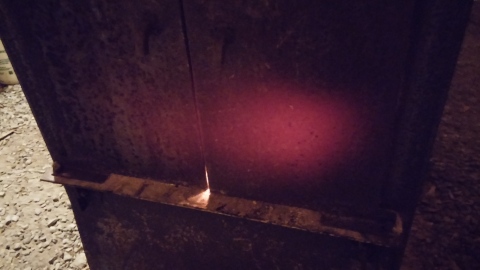
A strong run today filled all of my sap pails before I got to the last two trees. Operation of the arch has become a good deal more practical with the addition of a sap tank supported by my neighbour’s loader. It drips a steady stream of sap into the boiling tank, and all the operator has to do is shove in firewood and test for sweetness.
28 March
To describe today’s run using the phrase “of biblical proportions” would likely overstate the situation, but it’s certainly the fastest I have seen. One particularly exuberant maple seems to have split its trunk enough to leak a long line of sap down to the top of one root, where the stuff is foaming noticeably as it rejoins the earth.
All parties involved in the project have run out of storage, so until the boiler can reduce the quantity we’ll just have to let the buckets overflow. Could rain water have contaminated the sap? I tested today’s haul at 3.5% from one bucket. A sample from yesterday tested at 4%. I’d estimate a margin of error on this inexpensive meter of about 2%, plus or minus, so who knows?
27 March
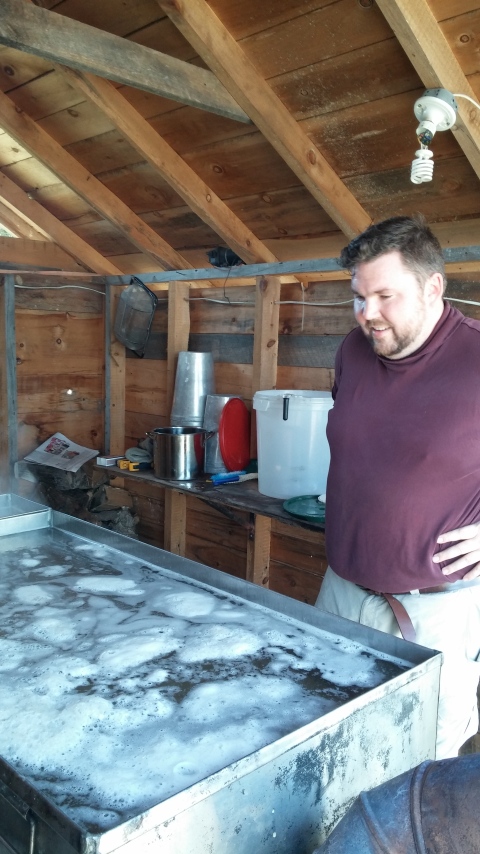
A huge sap run today. Rob Ewart had gathered 15 pails from our bush by 11:00 a.m. and another 12 by 6:00 p.m. from 41 taps. We finished 10.5 litres of syrup and have today’s sap ready to finish next at 30%.
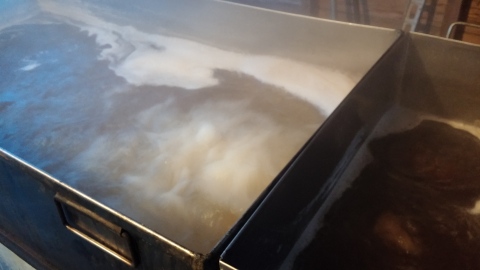
The neighbourhood syndicate had a similarly abundant run, so production is backed up around the capacity of the arch, but this is a good problem to have: too much sap, and too many good workers. Oh yes, and beautiful weather.
March 25
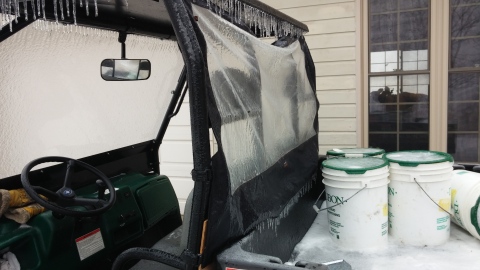
Roads were glare this morning, though the minor accretion on branches and wires did no harm. The spiles were plugged with ice at 9:00 a.m. Footing in the woods isn’t bad.
We sanded the driveway on the assumption that the car wouldn’t enjoy a sloped rink.
March 24
As the predicted ice storm moves into the area, my neighbours seem to be having an uncomfortable time of it while they boil their sap from yesterday’s run. Without the north wind to clear the vapour the shed is full of smog. When I turned on the light they all broke out laughing. The bulb was barely visible through the fog. As the fire gets hotter, conditions may improve.
March 23
It’s a great time of year to be outside in Eastern Ontario. If it weren’t for maple syrup, we’d just have to invent another excuse.
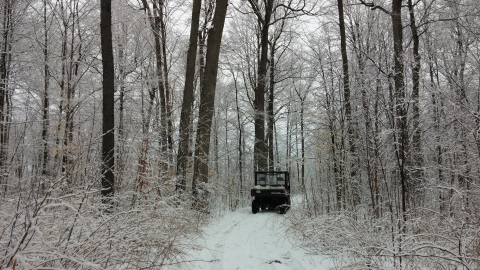
Sap ran well overnight despite the snow.
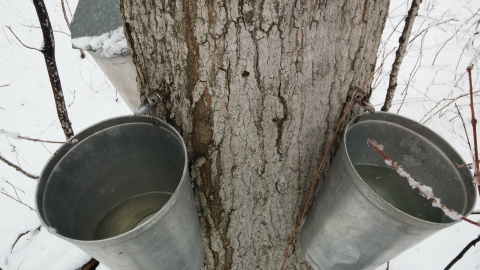
You never know how a piece of equipment will get used when you bring it to Young’s Hill.
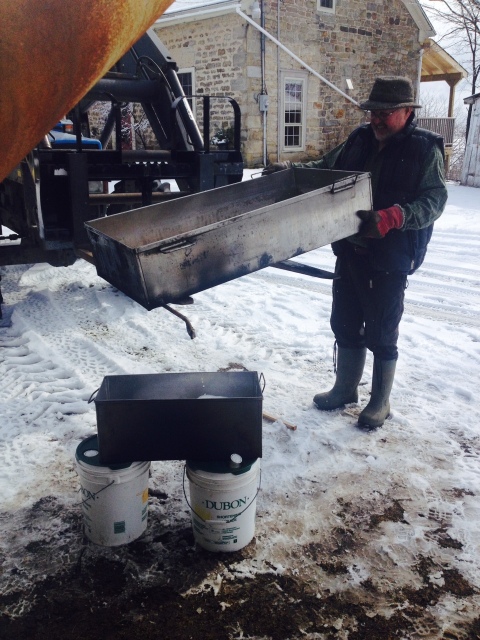
Turns out pallet forks on a loader make a great place to set a pan to get it away from the fire in the arch before the syrup turns to candy.
An excellent run overnight generated 170 litres in 41 buckets, so we quickly turned around to another all-day boil. We finished and bottled 10 litres of last night’s syrup about noon today.
Robert Ewart just returned from a 2:00 p.m. collection with an additional 50 litres of sap. My neighbour’s more sheltered bush produced very little sap after the morning collection today.
March 22
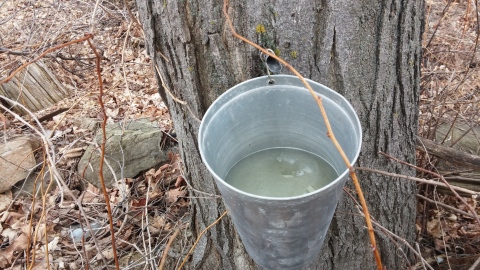
At 2:00 pm today the sap was running well. I gathered 100 litres from 41 buckets. Then my neighbours showed up with 108 litres from their 41 buckets. Their bush is a little more sheltered than mine. In any case, there’s lots of sap to boil for the next day or so.
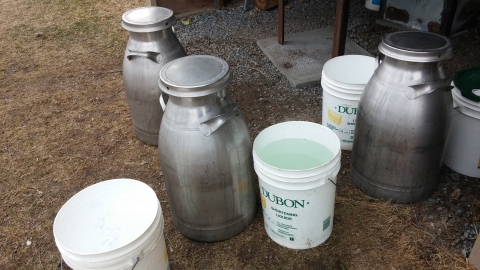
These 8 gallon, stainless steel containers, known as 80 pound cans, hauled milk to Forfar Dairy forty years ago. They cost $100 each when new. Farmers have the coolest sap pails.
My neighbour Burt stopped over this afternoon with a couple of small mason jars with more-or-less clear fluids in them. “Taste this. It won’t hurt you.” I took a sip of the ugly liquid. It tasted like stale, distilled water. “Now taste this.” Sap, rather sweet. “Once and for all, there is no sugar in the ice in a sap bucket. You can separate sugar from water in two ways: by boiling it, or by freezing it.”
March 21
After a frigid morning the sap began to run. We gathered 6 pails from my neighbour’s trees, but only 3 1/2 pails from my bush which is more exposed to the north wind. The crew boiled down the sap while finishing the 3 litres collected for Saturday’s boil. Taste tests for this batch were highly positive.
March 19
A big day in the Woodlot. Our son Charlie invited some friends to the farm to make maple syrup.
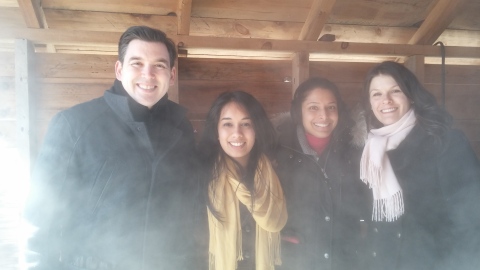
The day went very well, and the various guests were involved in all aspects of syrup production including tapping, driving the Ranger, boiling sap, finishing syrup, bottling, even gathering a limited amount of sap despite the cold.
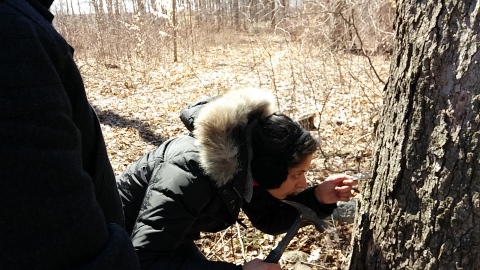
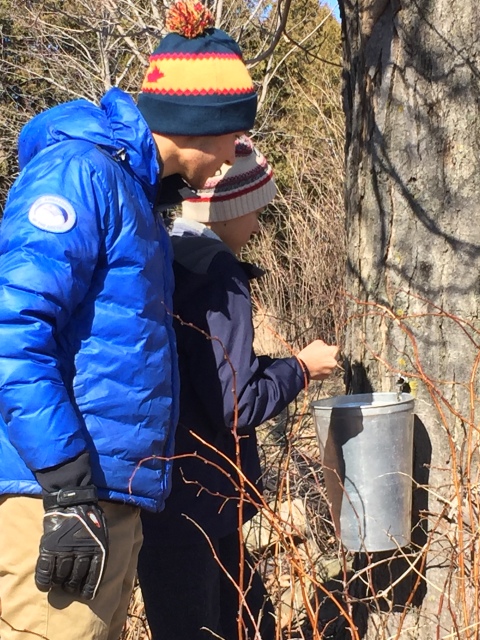
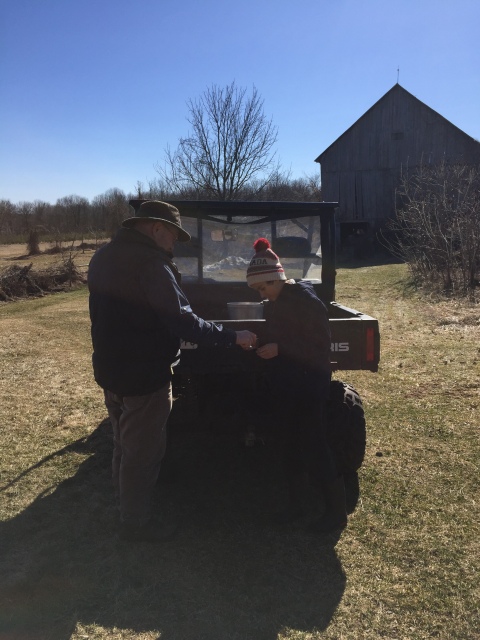
March 18
A strong north wind and dropping temperatures do not bode well for tomorrow’s visit to the sugar bush by guests who hail variously from Montreal, Kingston, Toronto and Vancouver. I hope they all wear long underwear.
A neighbour’s bush offered three pails of sap and ours reluctantly produced two. That’s less than optimal: I like to have 14 pails of sap for a good boil. On the other hand this sap is sweeter than the first run was. At least there’ll be a ready supply of the critical ingredient for Canada Tea.
Syrup producer Burt Mattice stopped by today. He told me that the first run syrup tastes like sugared water, but it’s beautifully light in colour. The later sap yields a different sugar, the one with the maple flavour. Sap won’t run again until the middle of next week, according to Burt. I’m becoming glad I boiled up those first two runs of sap. At least we now have 2 1/2 litres with the potential of another 3 1/2 when I finish it.
Burt suggested loading some buckets with water and letting the guests gather that while the cameras and phones whirl. He further specified, however, that water freezes much harder than sap, so I ought to “seed” the pails fairly close to the guests’ arrival.
March 16
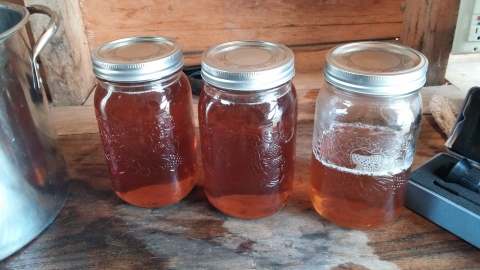
The task today was to tinker with the arch until it delivered an adequate supply of heat to the flat plate above the doors where I occasionally mount the small finishing tank. An earlier attempt had left me bewildered as it wouldn’t boil anything in that tank, though the main one over the open fire was vaporizing sap about as quickly as I could ladle it in.
Yesterday I bolted in place a corner of the galvanized sheeting which had bent away from the frame while riding around suspended from the loader. Then I used up a tub of stove putty on cracks to improve air circulation in the firebox. The finishing pan has worked well the last two years we used it, so the lack of heat had to be a problem of maintenance, rather than design.
This morning I put 5″ water in both tanks and lit a small fire at the very front of the firebox, next to the doors — in an effort to keep the heat beneath the tank which needed it.
I couldn’t get the thing up past 144 degrees F, even though the steel under it surpassed 575F and the other tank was boiling appreciably. Dipping water out until it had only about 10 litres left in it helped a bit, up to 165F, but nor further. I kept playing with the laser thermometer (thank you, Princess Auto) and found the odd cold spot. Sliding the pan around on the heating surface revealed it was a bit crooked and only sitting on three points. I pressed down firmly on the light implement, and then it agreed to boil. A tiny air gap provides amazing insulation: 575F on one side and 144F on the other.
Replacing the water with a sample of sap for finishing seemed the next logical step, so 7 litres of the 19 in the tub went into the pan. An hour passed with no progress except a steady progression to the indoor woodpile for small, dry pieces of hardwood which I cut in half with the band saw in an attempt to build a tall, narrow fire.
About the time the whole thing fell out the door onto the gravel below, the sap started to boil in earnest. While scrambling to gather up the coals before the dog stepped on one, I tested the syrup at 45%, then 54%, then 64%, at which point I filtered and bottled 2 1/2 litres of Forfar’s best light. It continues to cook through the bottling process, so I have learned to lead my target of 68%.
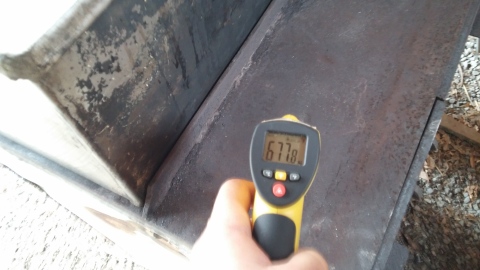
BTW: Plain water bubbled from the pan over an old tea bag (discovered in in a jar in the shop) offers none of the delight of Canada Tea.
March 13
22 L sap gathered by guests at 2:30 p.m.
5:15 p.m. Put 19 L boiled sap into finishing pan on the arch. 5.25″ depth, with 4 3/4″ sap (minimum depth) in the main pan and a second load of firewood.
7:15 p.m. 6″ liquid in main pan, boiling hard. Chased from fire pit by smouldering knees while attempting to adjust fire. Eventually realized that while whole area is panting hot, arch surface designated to finishing pan won’t boil spit. Reluctantly combined 19 L partially-boiled sap with the rest in main pan.
Possible causes of unexpected change:
- inferior wood 2. air leaks in arch directing heat away from heating plate 3. poor fire-building, failure to pile small, dry wood right to the top of front of firebox.
Shall ponder as knees cool.
8:20 p.m. 4 1/2″ and boiling. Refilled firebox.
9:15 p.m. 2 3/4″ and boiling fiercely, a substantial hickory block fully involved. Will check in an hour.
11:00 p.m. 1″* and no longer boiling, substantial quantity of glowing coals in firebox. I think it will cool down without damage to the pan from here.
* That’s the corner of the pan to the right of the chimney. At the middle of the pan, sap depth is more like 2″.
The emerging syrup, BTW, now tests at 25% (for a larger quantity than before) and is of a very light, clear quality. It’s sweet and a buyer would likely rate it high because of its clarity, but I find it lacks maple flavour.
12:20 a.m. I drew off 19 L sap/syrup which reads off the 5 to 30% scale of one refractometer and below the 40 to 80% scale of the other. Let’s call it half-way to the 68% target.
March 12
1:00 p.m. Transplanted a white birch from the plantation to the front lawn where a black cherry seedling had objected to wet feet. Full mud season approaches in the woodlot, though the paths to the trees we tap are gravelled.
2:30 p.m. Sap’s running slowly. Buckets will likely yield fractionally more than yesterday after this morning’s frost and bitter wind.
5:30 p.m. 5 1/2 pails sap collected (88 L). A total of 144 L from the two days should make a good boil, with enough energy to finish 19 L half-boiled sap in the small pan.
March 11
8:25 a.m. Puddles are frozen, mud in ruts is a little stiff, but in the woodlot the buckets are only lightly crusted. Will it run today? Time will tell.
2:30 p.m. Sap’s running slowly. Gathered 56 L sap. Beautiful afternoon in the woods.
March 10
The overnight run yielded only 24 litres, though the extra 1 1/2 pails made a short boil feasible this morning.
The tricky part of a short boil is figuring out how to end it. At the moment I’m out of sap. The pan is boiling at 3 1/2″ depth at its shallowest point.
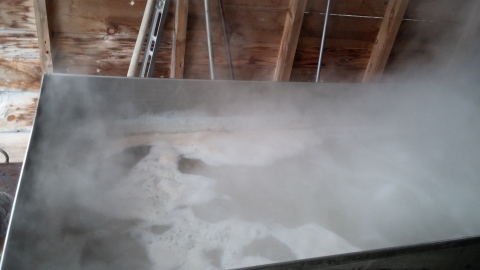
The fire is at the level below, down from blazing coals at the very top of the firebox.
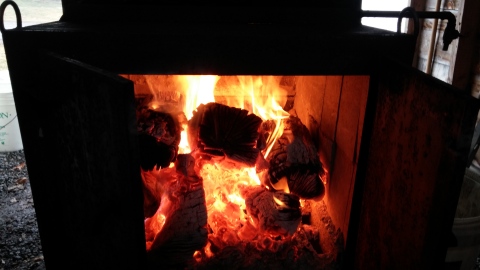
The plan is to coast down until there’s 1″ or less remaining in the pan. That will then cool and transfer to the small preheating pan for final boiling with the next sap event in the main pan.
Indicators of success in this risky game? 1″ or less of partially boiled sap in a cool pan.
Failure? 1. Water added to the mix to prevent the pan from burning. 2. A burned pan. 3. More partially-boiled sap than I can handle outside the main pan.
I’ll let you know how it works out. BTW, the sap doesn’t taste a bit sweet yet. It’s just hot, foamy water at this point, partly-boiled.
10:30: I made a cup of Canada Tea and relaxed to drink it. By the time I got back to the fire at 11:00, the coals were pretty well gone and the pan had stopped boiling at 2 3/4″, considerably short of the optimum depth of 3/4″. I added a couple of more armloads of maple firewood and refuse yet to admit to failure #3. BTW: the tea was sweet and delicious.
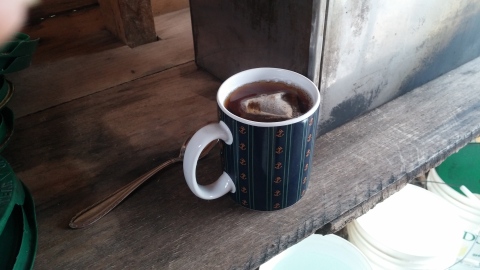
12:00 While the sap is no longer boiling strongly, its depth is down to 1 3/4″.
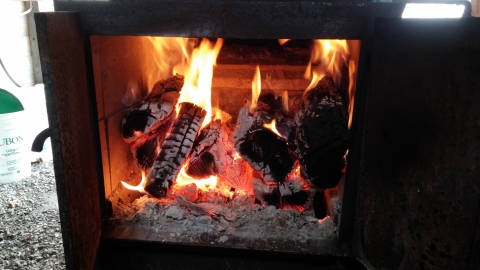
I think I’ll hold.
1:00 p.m. The arch is gradually cooling at 1 1/2″. The small pan has 1/5 the surface area of the large one. By this metric I can finish 7.5″ of enriched sap on the end of the arch during the next sap boil in the large pan, though 4″ would be easier.
When I revisited it at 2:30 the minimum tank level had subsided to 5/8″ and it was cool enough to pour off, so I decanted 19 litres into a pail, sealed it and stowed it in the shop for safekeeping. There’s a raccoon track in a soft spot on the driveway. A refractometer of questionable accuracy rated the sap at 14.5% sugar at this point in proceedings.
If the refractometer is accurate (a big if), the 19 L should produce 4 litres of syrup at 68% sugar.
March 9
After 24 hours the 32 buckets yielded 88 litres of darkish sap, but sweeter than I expected from a first run.
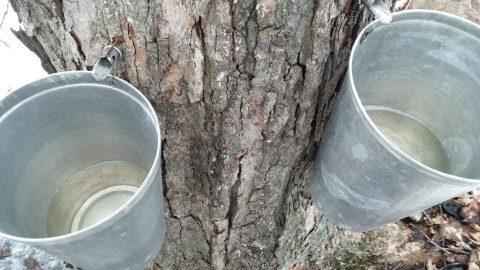
The Ranger was able to move more easily on the trail today as the snow is melting quickly.
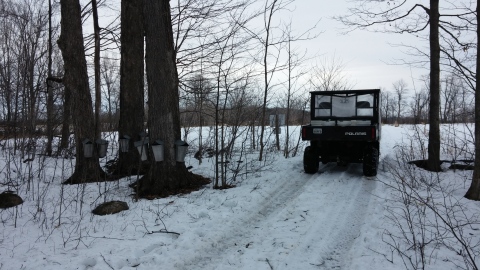
March
Three of us washed pans and buckets over the initial boil (water) in the pan. Tedious work, easily the worst part of sugar-making. In mid-afternood I drove the Ranger back to the bush and hung a few buckets.
March 7
Today I set the sugar arch up. This involved carrying the thing from its storage place in the old horse stable with the loader. The Massey Ferguson 35 is the only tractor on the farm which can do this, as it needs to reach into a stall with its narrow bucket, lift 700 pounds of steel, brick and concrete by chain, and carry it under a low barrier to its place in the sugar shack.
My 4′ X 2′ sap pan sits on this arch which my neighbour Peter Myers built for me. It’s a framework of steel enclosing fire brick above a heavy steel grate.
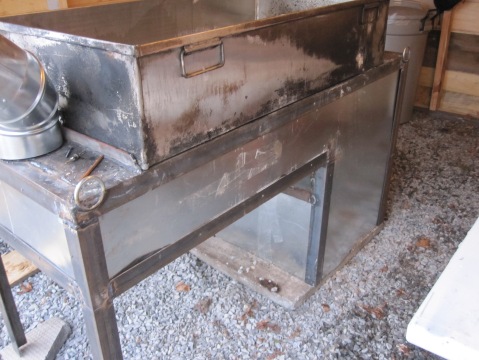
My design called for 24″ X 24″ concrete patio stones instead of pricey firebricks, but the stones enclosing the fire did not survive the first episode of the-way-we-did-things-in-other-years.
You see, the family sap pan had spent its first years of service propped up on a rough footing of loose concrete blocks. When it looked as if any delay would produce burned syrup, we would gingerly slide the pan, syrup and all, off the blocks and onto a convenient flat bed trailer.
My son Charlie and his friend Martin picked up on this old tradition. They dutifully boiled syrup well into the night, occasionally heading to the bush in a great hurry for a bit more sap so that the batch wouldn’t burn.
The open fire was o.k. on a clear night with little wind, though for the life of me I can’t remember one such night in the time we were making syrup over that open fire. Far more often a north wind blew the smoke and sparks back into the face of the unfortunate whose turn it was to stuff in more ironwood rails.
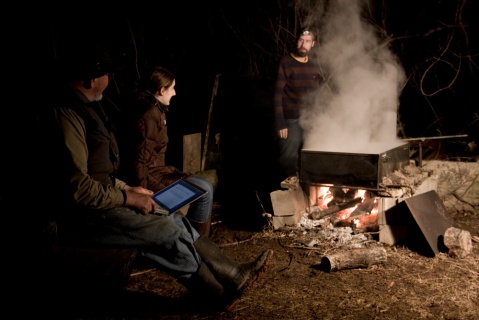
The whole thing was an ordeal, culminating in loud discussions as to when it was time to take the pan off the fire. Of course the moment it eventually left the frame there was suddenly no top on several bushels of coals, which immediately blazed up into an inferno. We learned to have a barrel of water at hand to douse the fire immediately after the pan had trundled to safety on the trailer.
When Charlie, Martin, Rob and I tried our first burn in the new arch in its borrowed shed, we luxuriated in the shelter and overhead lighting the new building provided. When the room filled with steam I simply backed the screws out of the clapboards from the gables so that air could flow through. This worked. The end boards have never been replaced as the shed works better without them.
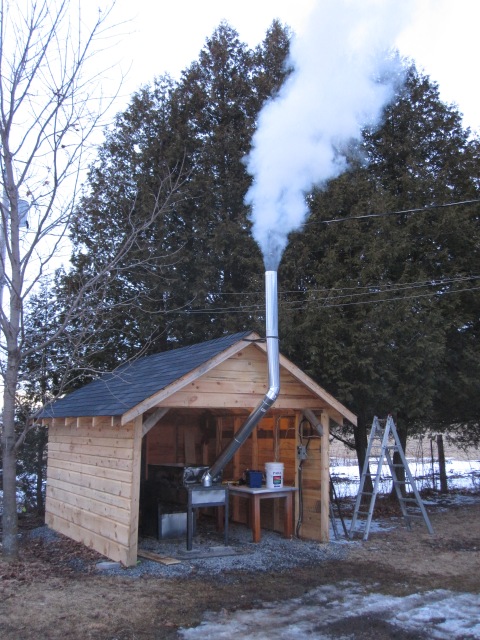
At the end of the boil we lifted the pan off, as usual Then I went somewhere to see to the bottling of the syrup. The boys dumped a couple of pails of water on the fire and all seemed well.
Two days later we lit another fire and had another 100 litres of sap about to break into a boil when a bomb went off in the shack, and then another in short succession. The galvanized sheeting and sturdy construction of the arch contained the blasts so nobody was hurt, but the two 2’X2′ patio stones which made up the sides of the fire box had blasted outward. The neat lines of the arch now looked like a bag of stove-top popcorn.
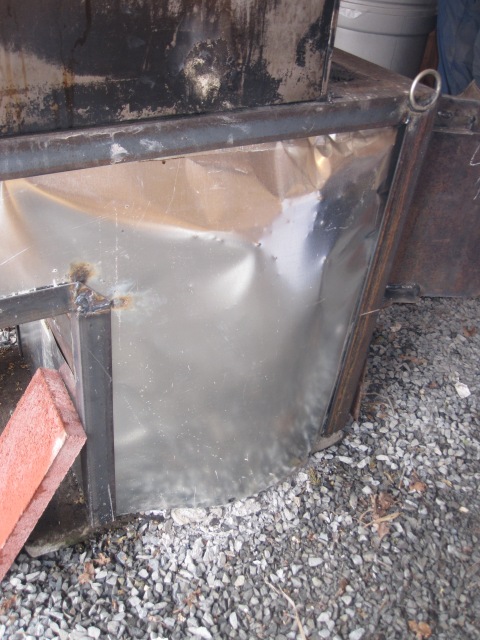
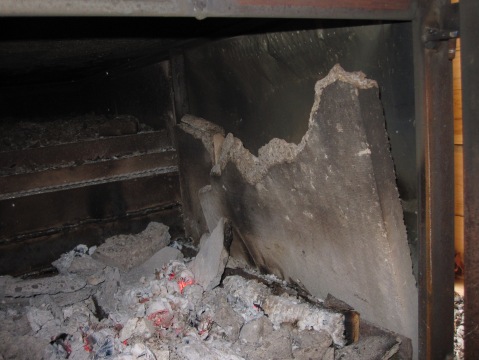
But we had sap to boil, so I immediately went to town and bought two boxes of fire brick to replace the patio stones. The boys* quickly learned that stove pipes and a fire box do a good job of containing a dying fire, so there’s no need to pour water on anything in there, as soaked concrete tends to explode loudly, with shrapnel, when heated.
*probably a misnomer, as the “boys” are now in their mid-thirties and well established on their careers.